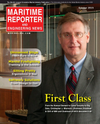
Page 16: of Maritime Reporter Magazine (October 2015)
Marine Design Annual
Read this page in Pdf, Flash or Html5 edition of October 2015 Maritime Reporter Magazine
MARINE DESIGN: ERGONOMICS
ErgonomicsSea@
BY THOMAS ASK rgonomics is the science Ergonomic design is not only easier and interface environment where small con- chology and interaction design. While of designing for the hu- more comfortable to use but reduces trols operating enormous machinery. other elements of human comfort will man body. The goal of injuries and accidents. Marine applica- The concepts behind ergonomics are not be discussed here, these include en- ergonomic design is to tions need special care because of vessel rooted in a variety of disciplines such as vironmental issues such temperature, allow interfaces to easily movement, unique hazards, multicultur- human dimensions (anthropometry), hu- humidity, draftiness, air quality, noise
Econnect with a human. al crew and the extreme human machine man movement (kinesiology), user psy- and vibration.
Fortunately, ergonomic design is sur- prisingly straight forward – simply de- sign human interfaces that put the body in a neutral position. Injuries or discom- fort increase when the hand, foot, arm, back etc. are compelled to operate out- side their neutral position. The second element of design is to allow customiza- tion of user interfaces. This customiza- tion can be dif? cult in marine design because much of the equipment and in- terfaces are rigidly mounted; however, it is an important to allow adjustments where possible.
Anthropometric data are readily avail- able for a wide array of demographics.
The ? gure below represents neutral body posture based on NASA data (Anthro- pometry and Biomechanics 1995).
Ergonomic design is based on data not intuition. One must speci? cally avoid the mistake of designing for oneself and assuming it will be satisfactory for ev- eryone else. Moreover, one should not assume a design for the average person is satisfactory for those at the outer ranges.
While many words and numbers are presented in connection with ergonom- ic design, for marine applications they break down to the following design guidance: • Design for the neutral position and the middle of the range of motion. • Empirically verify the effective- ness of the design. • Allow customization where pos- sible.
• Recognize vessel movement re- quires a range of angle be consid- ered so as not to produce pinch points or more subtle ergonomic problems.
Nasa 16 Maritime Reporter & Engineering News • OCTOBER 2015
MR #10 (10-17).indd 16 10/2/2015 1:21:43 PM

 15
15

 17
17
